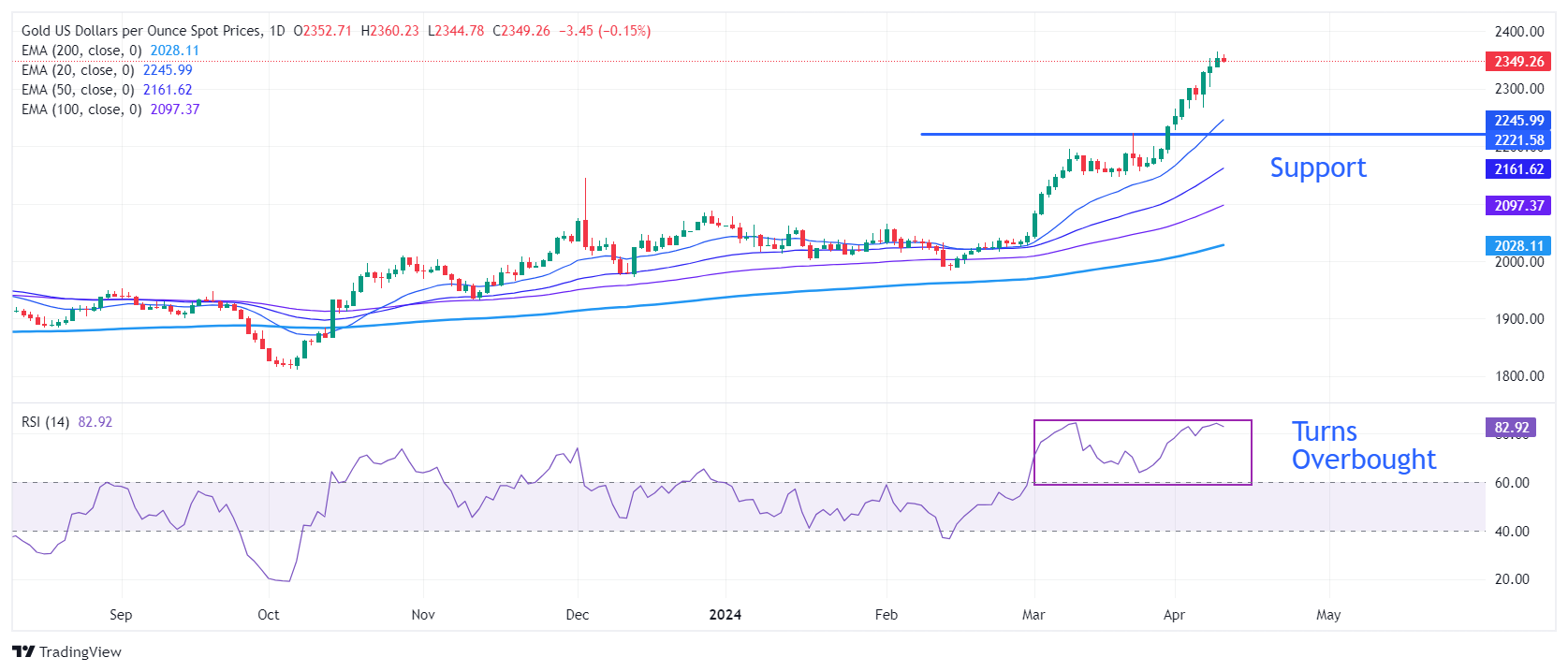- Gold price faces an intense sell-off on hot US inflation data for March.
- The US monthly headline and core CPI grew steadily by 0.4%.
- Escalating geopolitical tensions keeps the demand for Gold intact.
Gold price (XAU/USD) falls sharply from fresh highs of $2,365 in Wednesday’s early New York session as the United States Bureau of Labor Statistics (BLS) has reported a stubbornly higher Consumer Price Index (CPI) report for March. The inflation grew steadily on major parameters, while annual headline inflation accelerated further to 3.5% from expectations of 3.4% and the prior reading of 3.2%. Economists anticipated inflation to remain stubborn due to higher Oil prices, rentals, insurance costs and portfolio management fees.
Strong CPI data is expected to force traders to shift bets on the Federal Reserve (Fed) beginning to reduce interest rates sometime in the third quarter of this year. This scenario bodes well for interest-bearing assets, such as US bonds and the US Dollar. 10-year US Treasury yields soar to 4.5%. The US Dollar Index (DXY), which values the US Dollar’s strength against six major currencies, rallies to 104.80. Hotter-than-expected is expected to deepen uncertainty over the timing and number of rate cuts by the Federal Reserve (Fed), which policymakers anticipated three times this year.
Generally, the Fed’s longer-term maintenance of higher interest rates builds downside pressure on non-yielding assets such as Gold as it increases the cost of investing in them. Still, there has been an anomaly in Gold in the past few weeks, as its demand remained robust despite traders paring big bets on Fed rate cut prospects for the June meeting.
Daily digest market movers: Gold price falls sharply on hot US inflation
- Gold price drops vertically from fresh all-time highs of around $2,365 due to multiple headwinds. Stubbornly higher United States inflation data for March and strong payroll data combined with overbought momentum oscillators have put significant pressure on the Gold price. This has shaken investors’ confidence in the Federal Reserve reducing interest rates in June.
- US monthly headline and core CPI, which strips off volatile food and energy prices, both grew steadily by 0.4%. Economists forecasted them to grow slowly by 0.3%. The annual headline inflation rose strongly by 3.5% from expectations of 3.4% and the prior reading of 3.2%. The annual core inflation increased steadily by 3.8%. Investors anticipated it to decelerate slightly to 3.7%. Hot figures would allow the Fed to delay rate cut plans and will negatively impact speculation for the Fed pivoting to rate cuts in the June meeting.
- Earlier, the precious metal has experienced a great bull run in the last few weeks. Gold has remained the talk of the town in the past few weeks due to a fresh escalation in Middle East tensions, which has firmed safe-haven bids and pent-up demand for precious metals by global central banks. Central banks piled up Gold inventory as a hedge against a potential economic slowdown.
- Fading expectations of a ceasefire between Israel and Palestine also keep Gold demand buoyant. The Israeli proposal of a ceasefire on April 9 didn’t match the demands from Hamas, which wants Israel to withdraw its forces and allow displaced Palestinians to return to their homes.
Technical Analysis: Gold price retreats from fresh highs around $2,360

Gold price trades inside Wednesday’s trading range as the US inflation data comes under the spotlight. The precious metal hovers near fresh lifetime highs around $2,360. The near-term demand remains intact as all short-to-long-term Exponential Moving Averages (EMAs) are sloping higher.
On the downside, March 21 high at $2,223 will be a major support area for the Gold price bulls.
The 14-period Relative Strength Index (RSI) reaches 85.00, indicating a strong bullish momentum. However, extremely overbought signals could lead to a mild correction.
Inflation FAQs
Inflation measures the rise in the price of a representative basket of goods and services. Headline inflation is usually expressed as a percentage change on a month-on-month (MoM) and year-on-year (YoY) basis. Core inflation excludes more volatile elements such as food and fuel which can fluctuate because of geopolitical and seasonal factors. Core inflation is the figure economists focus on and is the level targeted by central banks, which are mandated to keep inflation at a manageable level, usually around 2%.
The Consumer Price Index (CPI) measures the change in prices of a basket of goods and services over a period of time. It is usually expressed as a percentage change on a month-on-month (MoM) and year-on-year (YoY) basis. Core CPI is the figure targeted by central banks as it excludes volatile food and fuel inputs. When Core CPI rises above 2% it usually results in higher interest rates and vice versa when it falls below 2%. Since higher interest rates are positive for a currency, higher inflation usually results in a stronger currency. The opposite is true when inflation falls.
Although it may seem counter-intuitive, high inflation in a country pushes up the value of its currency and vice versa for lower inflation. This is because the central bank will normally raise interest rates to combat the higher inflation, which attract more global capital inflows from investors looking for a lucrative place to park their money.
Formerly, Gold was the asset investors turned to in times of high inflation because it preserved its value, and whilst investors will often still buy Gold for its safe-haven properties in times of extreme market turmoil, this is not the case most of the time. This is because when inflation is high, central banks will put up interest rates to combat it. Higher interest rates are negative for Gold because they increase the opportunity-cost of holding Gold vis-a-vis an interest-bearing asset or placing the money in a cash deposit account. On the flipside, lower inflation tends to be positive for Gold as it brings interest rates down, making the bright metal a more viable investment alternative.

























